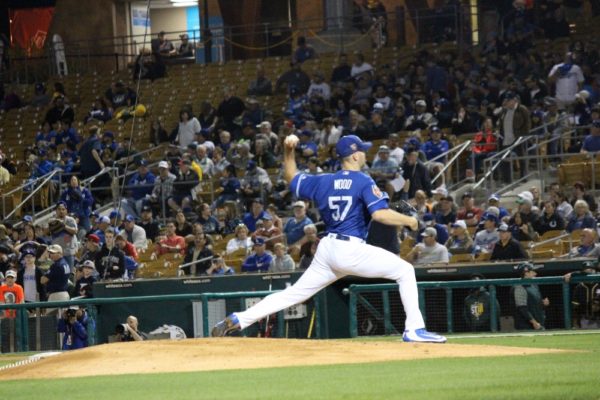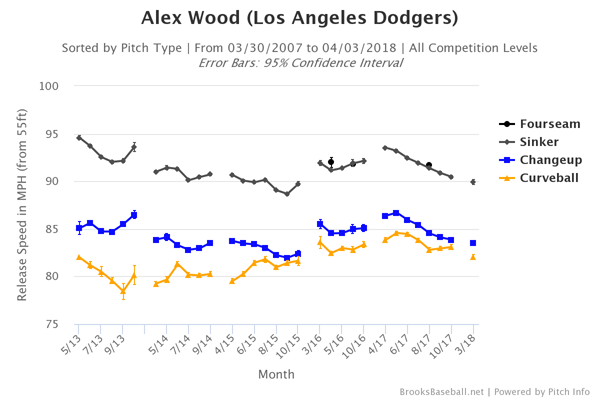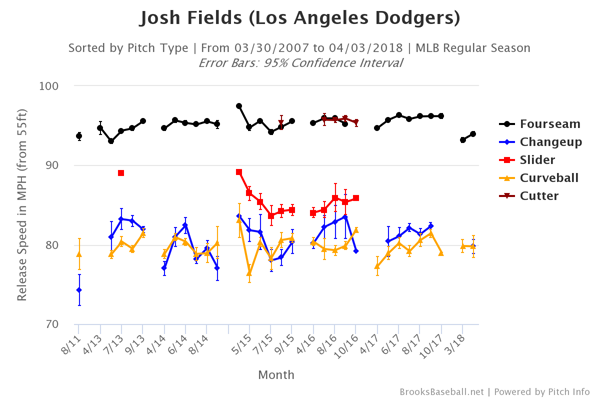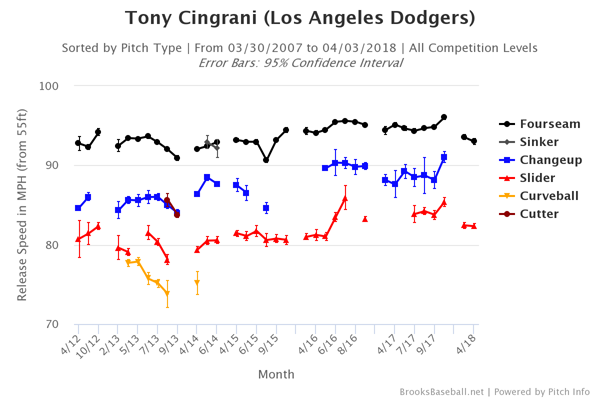
CORRECTION: After finding additional odd information in the pitch tracking data, it has been discovered that most of the information used to write this post is incorrect. When writing this piece, I checked every Dodger pitcher who pitched in both Los Angeles and Arizona to see if there was a park calibration difference between the two stadiums. Data were stable between the two. However, I did not check other Diamondbacks’ pitchers to see if their velocity was also down. Almost every Diamondback pitcher also showed a major velocity decline on Brooks Baseball. This would generally indicate a data error, and it was missed.
The pitch tracking information on FanGraphs and the pitch tracking information on Brooks are from the same source: PitchInfo. However, the information displayed on the two sites is currently extremely different. Kershaw’s average fastball velocity in 2018 on Brooks is 90.7, and on FanGraphs it’s 92.9. Jansen is at 90.1 on Brooks and 91.3 on FanGraphs. The three examples cited below are also significantly closer to their career norms, and not severely down as the article claims. Additionally, the FanGraphs data are likely to be adjusted in the days ahead, as calibration information is further tweaked.
As such, the premise of this article is wrong. We should still be monitoring Kershaw and Jansen, something is clearly up with them. However, the velocity issues cited below are the result of bad data, not a pitching staff-wide problem. I’d like to apologize for the factual errors. The original post is included below in the interest of transparency.
=====
Following completion of the Dodgers’ first game of the season, it was obvious that Clayton Kershaw‘s velocity was down. It takes a few days in order to determine how much his velocity was down, though, since each StatCast radar has a calibration factor. When Chad wrote his post on Kershaw’s velocity last week, the raw data from the start read as an average of 91.9 mph. There was some reason to be optimistic about that number going up after the calibration adjustment. After all, almost every other pitcher who threw that day had a lower velocity than normal, too. If all pitchers had lower velocities than normal, it stood to reason that the calibrated velocity might be low. Then Kenley Jansen came in the next day throwing soft, which raised even more alarms.
However, after a full five games (including a move to a different stadium), things are even more worrying. It turns out that the average reading from the Dodgers’ StatCast postgame data was actually too high. PitchInfo (which provides data to Brooks Baseball) provides adjustments for radar calibration and pitch classification in their data, and they posted their first adjusted information of the year after the conclusion of last night’s game. After that correction, Kershaw’s average fastball velocity from his first start was 90.7mph, not 91.9. Last year Kershaw averaged 93.2 mph, and last April he averaged 93.6. The average velocity on Jansen’s cutter was 88.6 mph in his first outing and 91.4 in his second, down from an average of 93.6 last season.
Kershaw and Jansen are the two pitchers most critical to the Dodgers’ success this season, and we will absolutely have more coverage on their velocity issues as the season unfolds. However, it is worth noting that many other Dodgers seem to be suffering from velocity problems as well. Take last season’s most famous velocity decliner, Alex Wood:

In his first start, Wood’s two-seamer averaged 89.9 mph, a continuation of last season’s precipitous velocity loss. Wood was very effective in that outing, but it’s hard not to remember how much his results suffered as the season wore on (excellent World Series numbers aside).
The bullpen has not been immune to these issues, either. If Jansen is injured (which the Dodgers deny, but a six-second shot of him rubbing his pitching shoulder last night says it could be otherwise), one candidate to replace him in a closer role is Josh Fields. However:

In his three outings this season, Fields has averaged 93.8 mph on his fastball. Last season, that average was 95.8. Fields did start a little slow last year as well (94.7 mph in April), but it’s still a loss. For a pitcher who makes his living blowing a fastball by hitters, that’s a major concern.
If Fields isn’t ready, next in line after him is probably Tony Cingrani. But, well, I think you know what’s coming:

Last season, Cingrani averaged 94.7 mph on his fastball. After his first few outings of the year, he’s at 93.4. These issues also extend to Ross Stripling (down 1 mph), Scott Alexander (down 1.6 mph but in line with last April), and Rich Hill (down 0.9 mph). The only Dodger pitchers without a major decline in fastball velocity so far are JT Chargois (because he didn’t pitch in the majors last year), Wilmer Font (because he barely pitched in the majors last year), Pedro Baez, Hyun-Jin Ryu, and Kenta Maeda.
Problems with fastball velocity are impacting pretty much the entire team. The critical question then becomes “Why?”, which is significantly more difficult to answer. Even after a numbers-heavy post it becomes extremely important to emphasize that we are only five games into the season. All of these numbers could go back to normal tonight and it wouldn’t really surprise anybody. There’s also the issue of how late the Dodgers pitched last season. This is uncharted territory for almost everybody. Having two fewer weeks off could be a significant issue for some pitchers, and the Dodgers responded by easing Spring Training workloads in some cases. It’s possible that the velocities will come back to normal in a few more weeks as a part of a normal spring ramp-up. Perhaps this is the real “World Series hangover,” not an issue with lack of effort, but an issue with extended preparation time being needed.
It’s too early in the season to panic, but given the sheer number of players who aren’t finding their velocity, it isn’t too early to be at least somewhat concerned.
 Dodgers Digest Los Angeles Dodgers Baseball Blog
Dodgers Digest Los Angeles Dodgers Baseball Blog